Characteristics of the Blitzortung.org Lightning Location Catalog in Japan
Abstract
1. Introduction
2. Observation and Lightning Catalog
3. Statistical Studies
4. Event Studies
5. Discussion
6. Conclusions
Author Contributions
Funding
Data Availability Statement
Acknowledgments
Conflicts of Interest
References
- Betz, H.D.; Schumann, U.; Laroche, P. (Eds.) Lightning: Principles, Instruments, and Applications; Springer: Dordrecht, The Netherlands, 2009. [Google Scholar]
- Lewis, E.A.; Harvey, R.B.; Rasmussen, J.E. Hyperbolic direction finding with sferics of transatlantic origin. J. Geophys. Res. 1960, 65, 1879–1905. [Google Scholar] [CrossRef]
- Dowden, R.L.; Brundell, J.B.; Rodger, C.J. VLF lightning location by time of group arrival (TOGA) at multiple sites. J. Atmos. Sol.-Terr. Phys. 2002, 64, 817–830. [Google Scholar] [CrossRef]
- Christian, H.J.; Blakeslee, R.J.; Boccippio, D.J.; Boeck, W.L.; Buechler, D.E.; Driscoll, K.T.; Goodman, S.J.; Hall, J.M.; Koshak, W.J.; Mach, D.M.; et al. Global frequency and distribution of lightning as observed from space by the Optical Transient Detector. J. Geophys. Res. 2003, 108, ACL 4-1–ACL 4-15. [Google Scholar] [CrossRef]
- Cecil, D.J.; Buechler, D.E.; Blakeslee, R.J. Gridded lightning climatology from TRMM-LIS and OTD: Dataset description. Atmos. Res. 2012, 135–136, 404–414. [Google Scholar] [CrossRef]
- Blakeslee, R.J.; Lang, T.J.; Koshak, W.J.; Buechler, D.; Gatlin, P.; Mach, D.M.; Stano, G.T.; Virts, K.S.; Walker, T.D.; Cecil, D.J.; et al. Three Years of the Lightning Imaging Sensor Onboard the International Space Station: Expanded Global Coverage and Enhanced Applications. J. Geophys. Res. Atmos. 2020, 125, e2020JD032918. [Google Scholar] [CrossRef]
- Montanyà, J.; López, J.A.; Morales Rodriguez, C.A.; van der Velde, O.A.; Fabró, F.; Pineda, N.; Navarro-González, J.; Reglero, V.; Neubert, T.; Chanrion, O.; et al. A Simultaneous Observation of Lightning by ASIM, Colombia-Lightning Mapping Array, GLM, and ISS-LIS. J. Geophys. Res. Atmos. 2021, 126, e2020JD033735. [Google Scholar] [CrossRef]
- Rudlosky, S.D.; Goodman, S.J.; Virts, K.S.; Bruning, E.C. Initial geostationary lightning mapper observations. Geophys. Res. Lett. 2019, 46, 1097–1104. [Google Scholar] [CrossRef]
- Holzworth, R.H.; McCarthy, M.P.; Brundell, J.B.; Jacobson, A.R.; Rodger, C.J. Global distribution of superbolts. J. Geophys. Res. Atmos. 2009, 124, 9996–10005. [Google Scholar] [CrossRef]
- Zhu, Y.; Stock, M.; Lapierre, J.; DiGangi, E. Upgrades of the Earth Networks Total Lightning Network in 2021. Remote Sens. 2022, 14, 2209. [Google Scholar] [CrossRef]
- Said, R.; Murphy, M.J. GLD360 upgrade: Performance analysis and applications. In Proceedings of the 24th International Lightning Detection Conference and International Lightning Meteorology Conference, San Diego, CA, USA, 18–21 April 2016. [Google Scholar]
- Matsui, M.; Michishita, K.; Kurihara, S. Accuracies of location and estimated peak current for negative downward return-strokes to wind turbine observed by JLDN. IEEJ Trans. Power Energy 2015, 135, 644–645. [Google Scholar] [CrossRef]
- Matsui, M.; Michishita, K.; Kurihara, S.; Honjo, N. Discussion on Location Accuracy Improved by Propagation Delay Correction for Japanese Lightning. In Proceedings of the 33rd International Conference on Lightning Protection (ICLP), Estoril, Portugal, 25–30 September 2016. [Google Scholar] [CrossRef]
- Ishii, M.; Saito, M.; Fujii, F.; Hojo, J.; Matsui, M.; Itamoto, N.; Shinjo, K. LEMP from lightning discharge observed by JLDN. IEEJ Trans. Power Energy 2005, 125, 765–770. [Google Scholar] [CrossRef][Green Version]
- Shindo, T.; Motoyama, H.; Sakai, A.; Honma, N.; Takami, J.; Shimizu, M.; Tamura, K.; Shinjo, K.; Ishikawa, F.; Ueno, Y.; et al. Lightning occurrence characteristics in Japan for 17 years: Observation results with lightning location systems of electric power utilities from 1992 to 2008. IEEJ Trans. 2012, 7, 251–257. [Google Scholar] [CrossRef]
- Ishii, K.; Hayashi, S.; Fujibe, F. Statistical analysis of temporal and spatial distributions of cloud-to-ground lightning in Japan from 2002 to 2008. Atmos. Electricity 2014, 34, 79–86. [Google Scholar] [CrossRef][Green Version]
- Wanke, E.; Andersen, R.; Volgnandt, T. A World-Wide Low-Cost Community-Based Time-of-Arrival Lightning Detection and Lightning Location Network (Project Description; 11 May 2014). Available online: https://www.blitzortung.org/en/cover_your_area.php (accessed on 1 January 2023).
- Wanke, E. Private communication, 2023.
- Narita, T.; Wanke, E.; Sato, M.; Sakanoi, T.; Kumada, A.; Kamogawa, M.; Ishikawa, H.; Harada, S.; Kameda, T.; Tsuchiya, F.; et al. A Study of Lightning Location System (Blitz) Based on VLF Sferics. In Proceedings of the 34th International Conference on Lightning Protection (ICLP), Rzeszow, Poland, 2–7 September 2018. [Google Scholar] [CrossRef]
- Narita, T. Private communication, 2023.
- Koshak, W.J.; Solakiewicz, R.J. TOA lightning location retrieval on spherical and oblate spheroidal earth geometries. J. Atmos. Oceanic Tech. 2001, 18, 187–199. [Google Scholar] [CrossRef]
- Miyazaki, T.; Michimoto, K.; Suzuki, T.; Okada, T.; Kusunoki, K.; Hayakawa, M.; Kimura, J.; Hayakawa, S. Percentage of summer positive & negative lightning discharges and lightning current at the dissipating stage. J. Atmos. Electr. 2011, 31, 71–83. [Google Scholar]
- Goto, Y.; Narita, K. Electrical characteristics of winter lightning. J. Atmos. Terr. Phys. 1995, 57, 449–458. [Google Scholar] [CrossRef]
- Rhodes, C.T.; Shao, X.M.; Krehbiel, P.R.; Thomas, R.J.; Hayenga, C.O. Observations of lightning phenomena using radio interferometry. J. Geophys. Res. 1994, 99, 13059. [Google Scholar] [CrossRef]
- Rison, W.; Thomas, R.J.; Krehbiel, P.R.; Hamlin, T.; Harlin, J. A GPS-based three-dimensional lightning mapping system: Initial observations in Central New Mexico. Geophys. Res. Lett. 1999, 26, 3573–3576. [Google Scholar] [CrossRef]
- Zhu, Y.; Bitzer, P.; Rakov, V.; Ding, Z. A machine-learning approach to classify cloud-to-ground and intracloud lightning. Geophys. Res. Lett. 2021, 48, e2020GL091148. [Google Scholar] [CrossRef]
- Nag, A.; Rakov, V.A. Pulse trains that are characteristic of preliminary breakdown in cloud-to-ground lightning but not followed by return stroke pulses. J. Geophys. Res. 2008, 113, D01102. [Google Scholar] [CrossRef]
- Orville, R.E.; Huffines, G.R.; Burrows, W.R.; Holle, R.L.; Cummins, K.L. The North American Lightning Detection Network (NALDN)—First results: 1998–2000. Mon. Weather Rev. 2002, 133, 2098–2109. [Google Scholar] [CrossRef]
- Betz, H.-D.; Schmidt, K.; Oettinger, P.; Wirz, M. Lightning detection with 3-D discrimination of intracloud and cloud-to-ground discharges. Geophys. Res. Lett. 2004, 31, L11108. [Google Scholar] [CrossRef]
- Abarca, S.F.; Corbosiero, K.L.; Galarneau, T.J., Jr. An evaluation of the Worldwide Lightning Location Network (WWLLN) using the National Lightning Detection Network (NLDN) as ground truth. J. Geophys. Res. 2010, 115, D18206. [Google Scholar] [CrossRef]
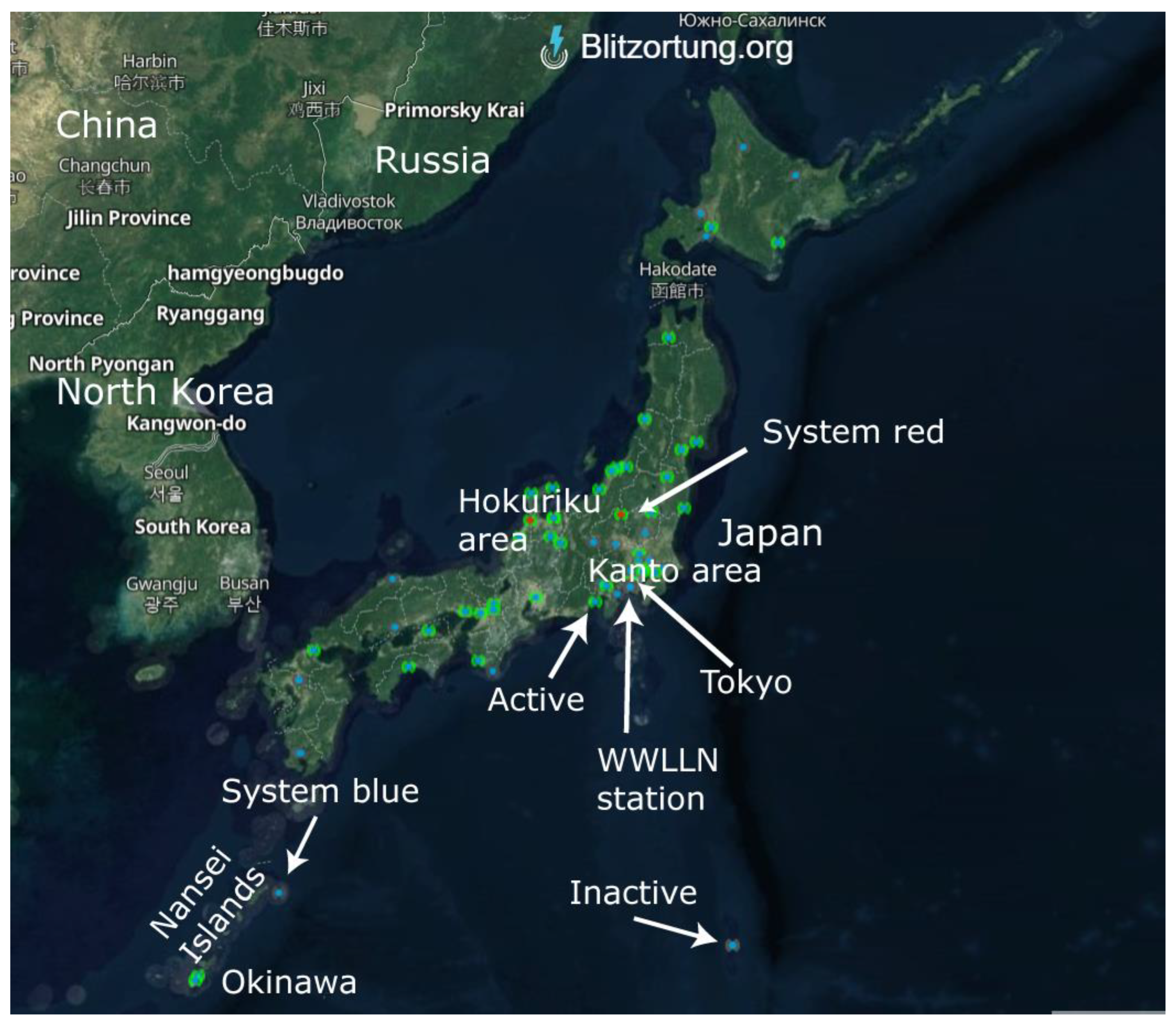


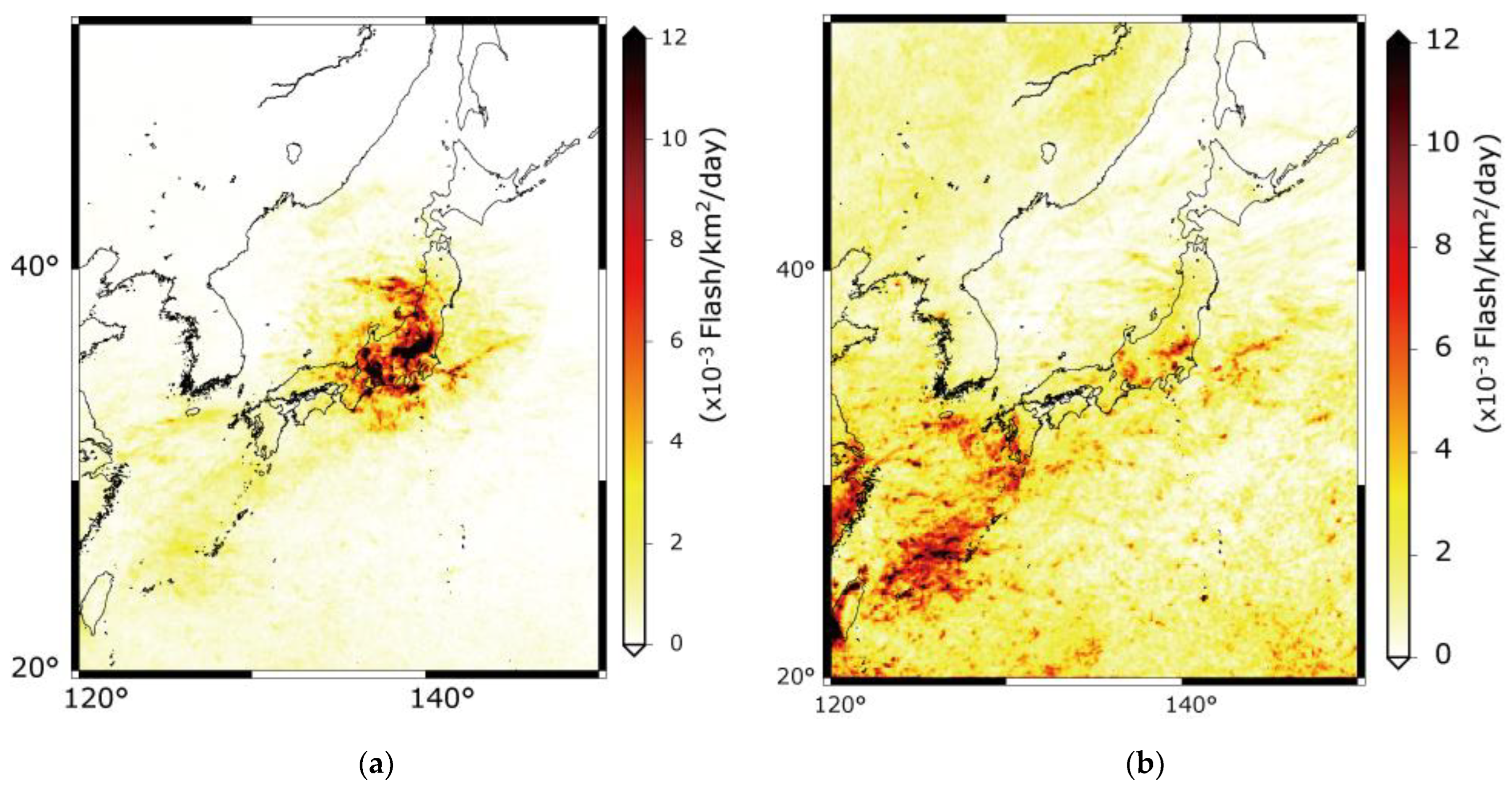
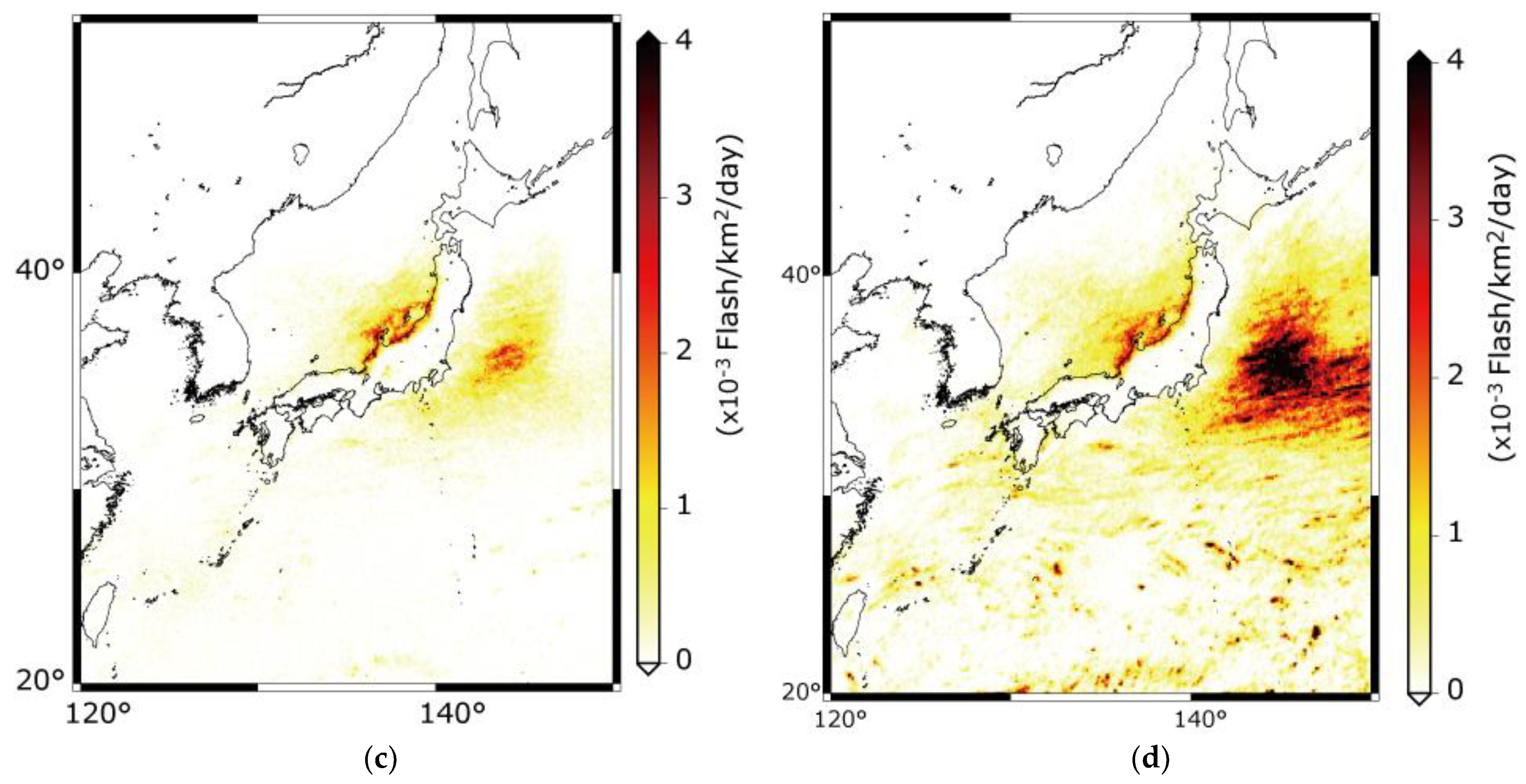
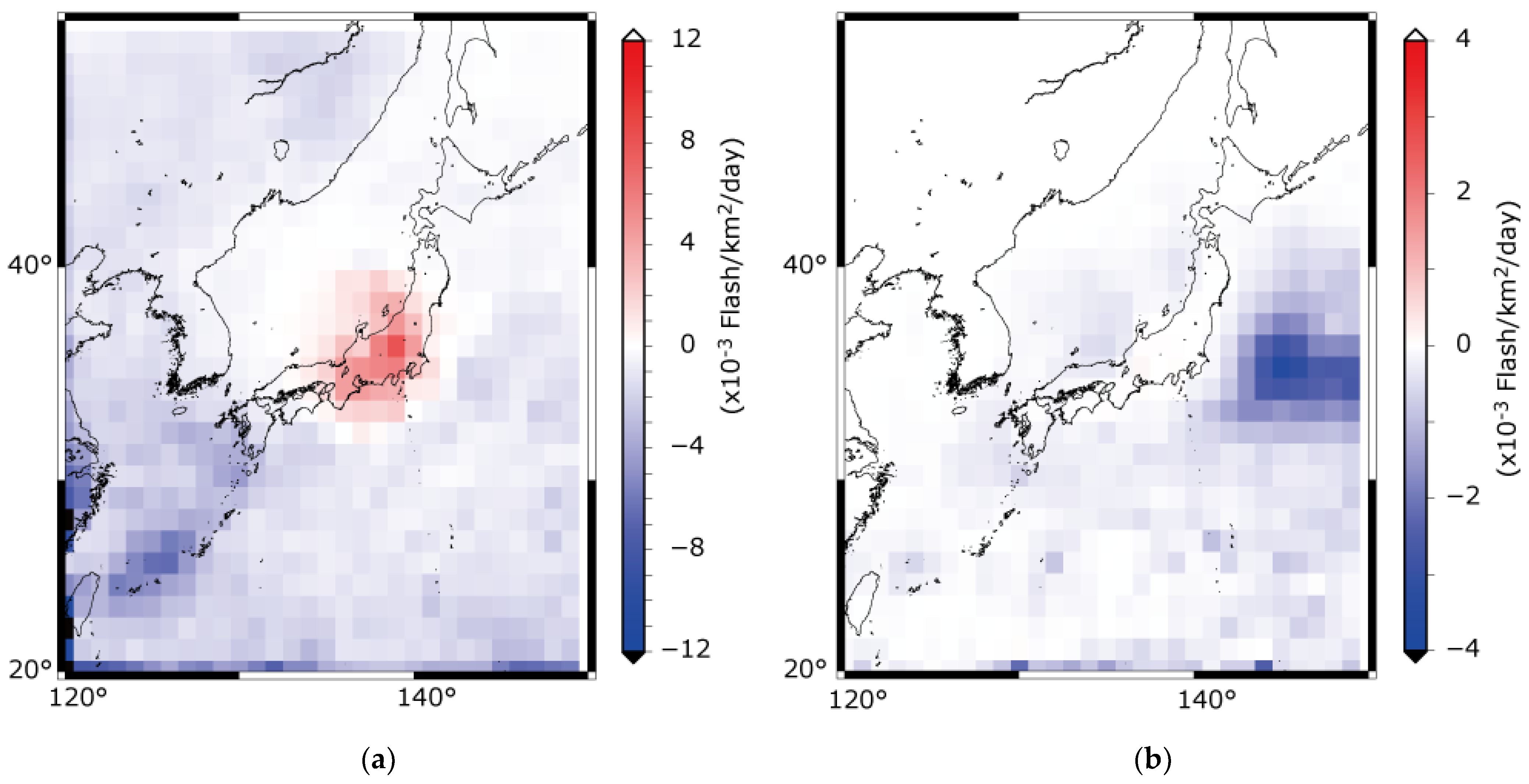
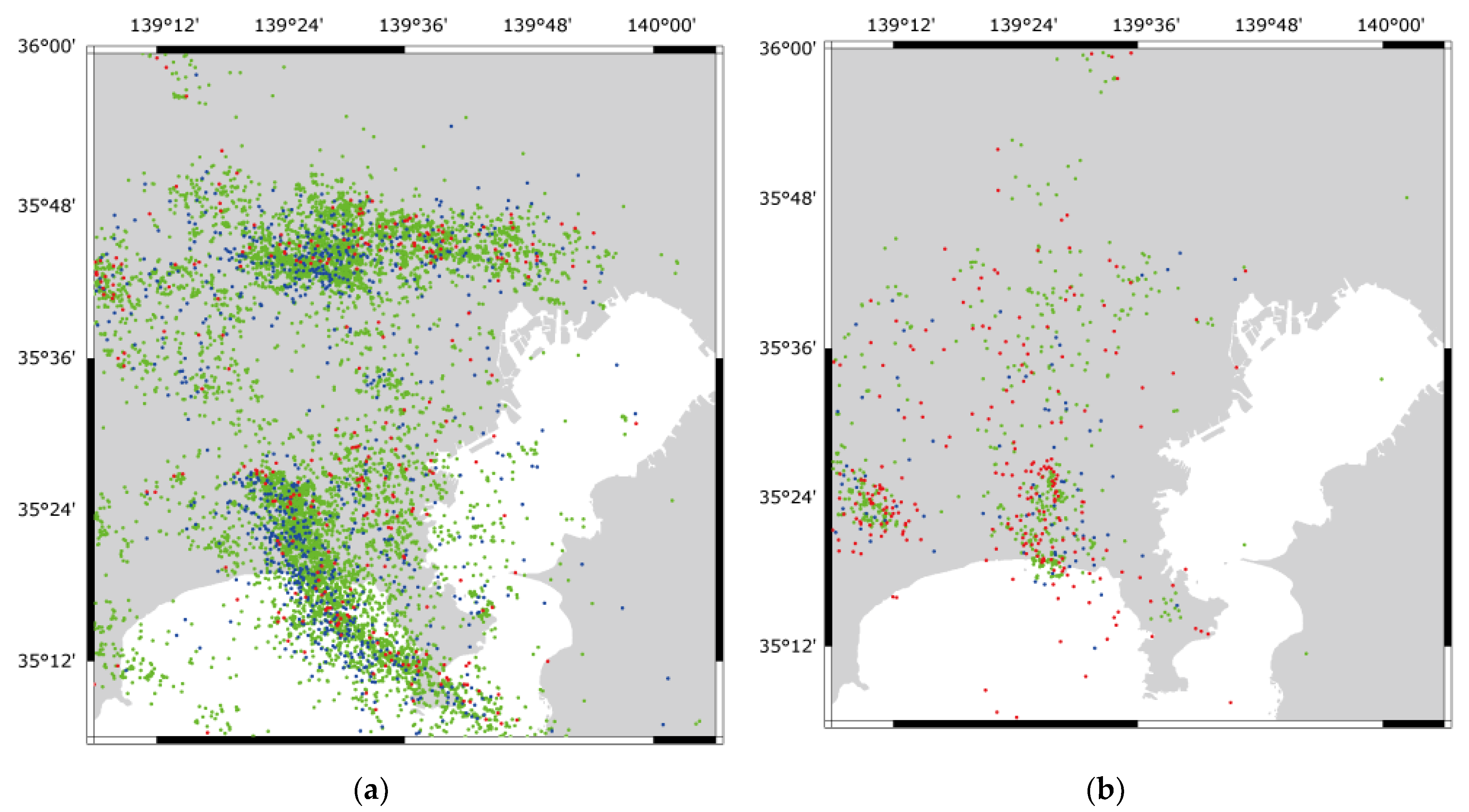
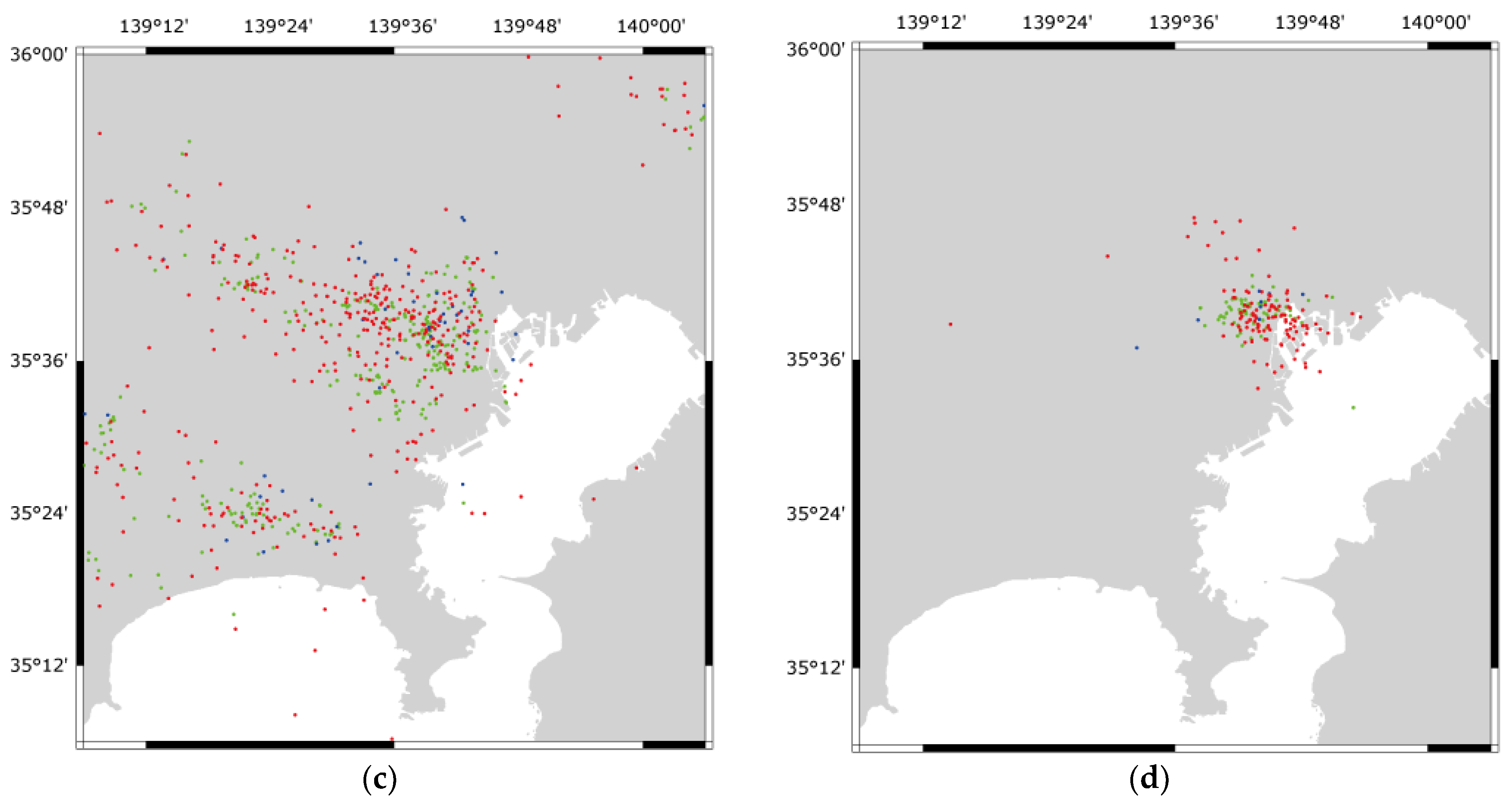
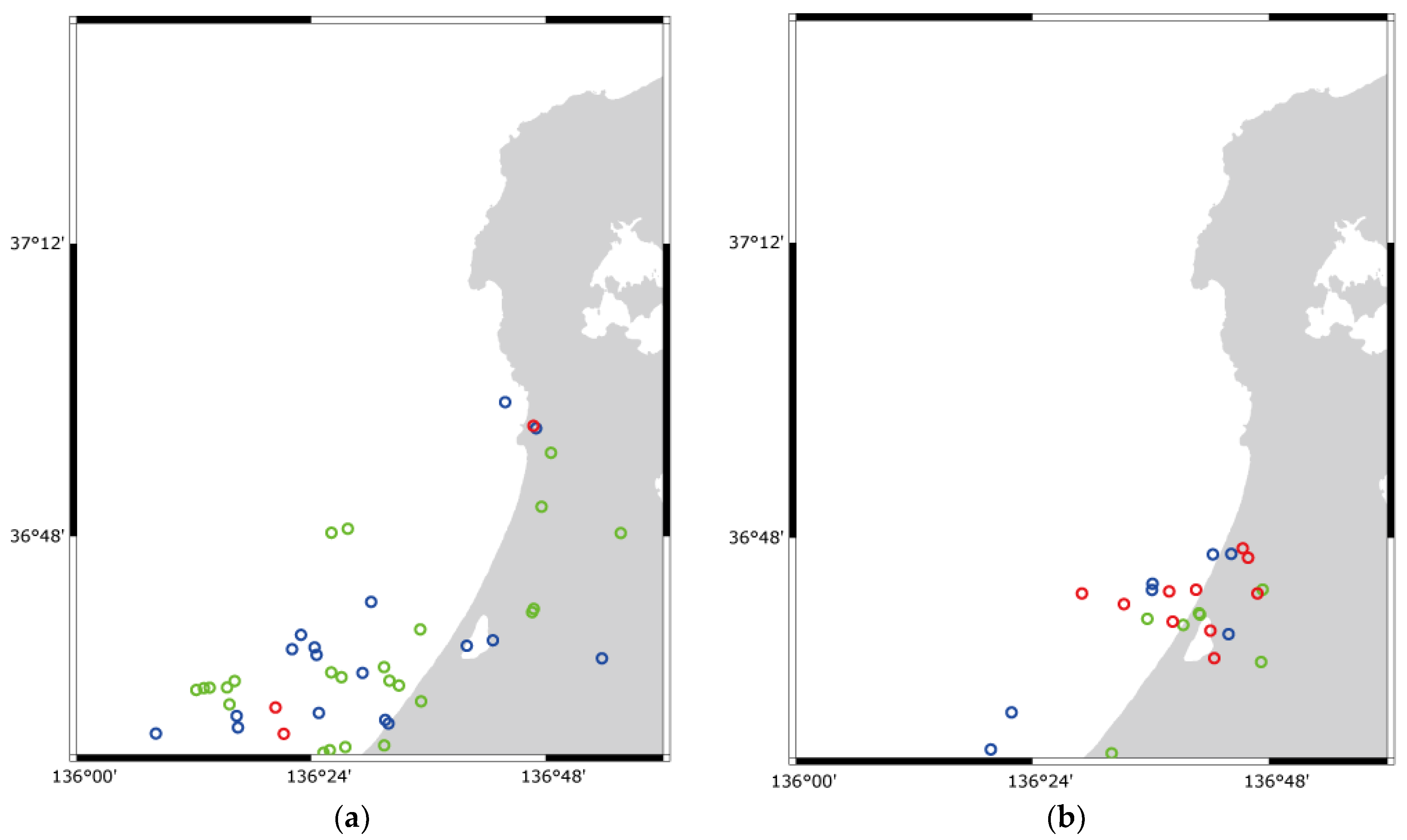
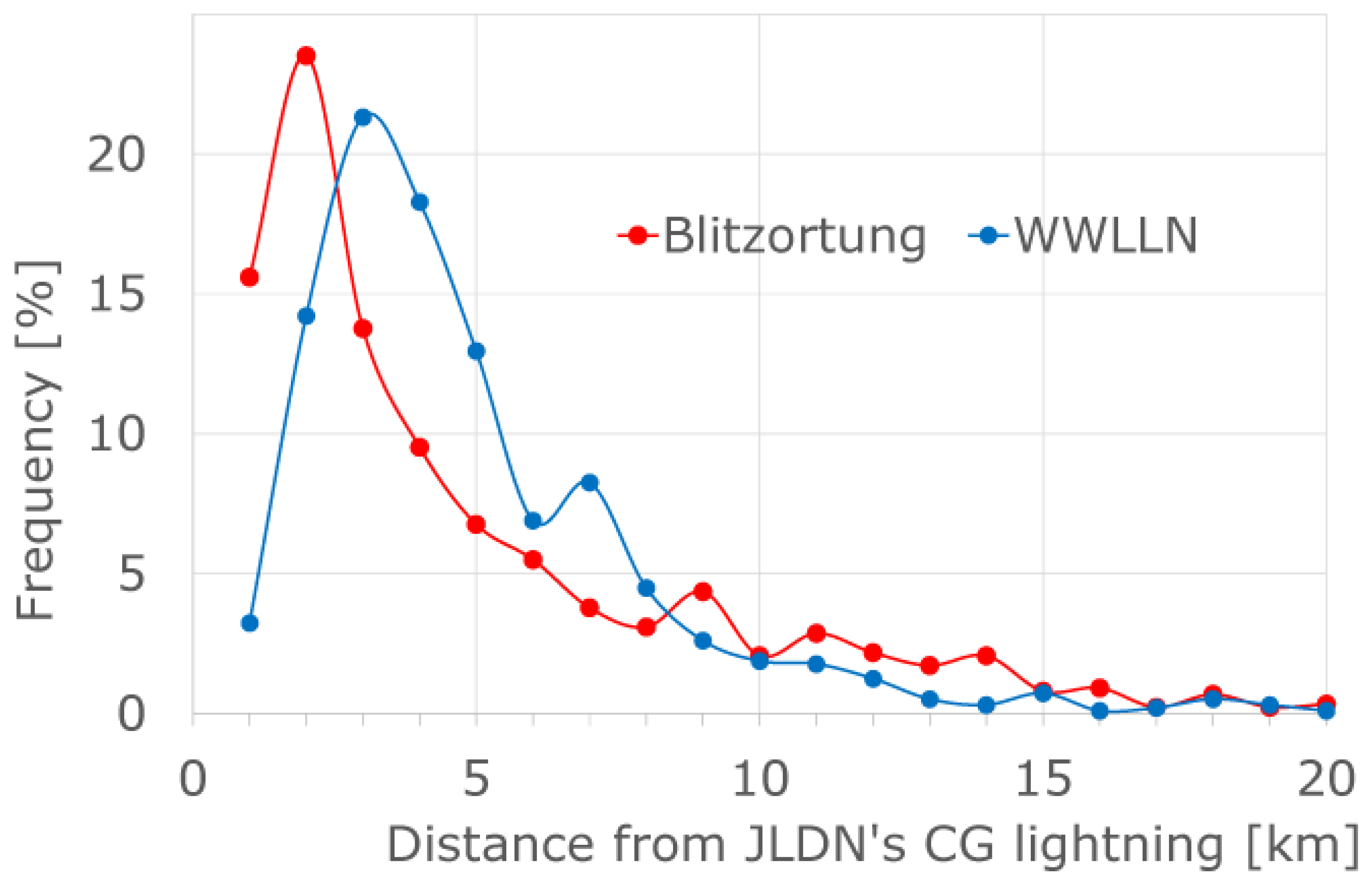
| (a) 7/18/2017, 4:00–7:00 UTC. | ||
| Number of JLDN Detections 8322 Detections | WWLLN 878 Detections | Blitzortung 305 Detections |
| Percentage of JLDN CG strokes and detections, synchronized | 866/878 (98.6%) | 287/305 (94.1%) |
| Detection efficiency relative to JLDN | 866/8322 10.4% | 287/8322 3.4% |
| (b) 5/4/2019, 4:30–7:00 UTC. | ||
| Number of JLDN detections 588 detections | WWLLN 78 detections | Blitzortung 247 detections |
| Percentage of JLDN CG strokes and detections, synchronized | 65/78 (83%) | 205/247 (83%) |
| Detection efficiency relative to JLDN | 65/588 11.1% | 205/588 34.9% |
| (c) 6/3/2022, 2:00–6:00 UTC. | ||
| Number of JLDN detections 368 detections | WWLLN 171 detections | Blitzortung 371 detections |
| Percentage of JLDN CG strokes and detections, synchronized | 46/171 (26.9%) | 308/371 (86.0%) |
| Detection efficiency relative to JLDN | 46/368 12.5% | 308/368 86.7% |
| (d) 8/3/2022, 4:00–7:00 UTC. | ||
| Number of JLDN detections 112 detections | WWLLN 9 detections | Blitzortung 117 detections |
| Percentage of JLDN CG strokes and detections, synchronized | 10/9 (111.1%) | 106/117 (90.6%) |
| Detection efficiency relative to JLDN | 10/112 8.9% | 106/112 94.6% |
| (a) 12/18/2020, 11:30–12:30 UTC. | ||
| Number of JLDN Detections 24 Detections | WWLLN 17 Detections | Blitzortung 3 Detections |
| Percentage of JLDN CG strokes and detections, synchronized | 10/17 (58.8%) | 2/3 (66.7%) |
| Detection efficiency relative to JLDN | 17/24 41.7% | 2/24 12.5% |
| (b) 12/18/2021, 22:30–23:30 UTC. | ||
| Number of JLDN detections 7 detections | WWLLN 7 detections | Blitzortung 10 detections |
| Percentage of JLDN CG strokes and detections, synchronized | 5/7 (71.4%) | 5/10 (50%) |
| Detection efficiency relative to JLDN | 5/7 71.4% | 10/7 142.9% |
Disclaimer/Publisher’s Note: The statements, opinions and data contained in all publications are solely those of the individual author(s) and contributor(s) and not of MDPI and/or the editor(s). MDPI and/or the editor(s) disclaim responsibility for any injury to people or property resulting from any ideas, methods, instructions or products referred to in the content. |
© 2023 by the authors. Licensee MDPI, Basel, Switzerland. This article is an open access article distributed under the terms and conditions of the Creative Commons Attribution (CC BY) license (https://creativecommons.org/licenses/by/4.0/).
Share and Cite
Kamogawa, M.; Suzuki, T.; Fujiwara, H.; Narita, T.; Wanke, E.; Murata, K.; Nagao, T.; Kodama, T.; Izutsu, J.; Matsuki, A.; et al. Characteristics of the Blitzortung.org Lightning Location Catalog in Japan. Atmosphere 2023, 14, 1507. https://doi.org/10.3390/atmos14101507
Kamogawa M, Suzuki T, Fujiwara H, Narita T, Wanke E, Murata K, Nagao T, Kodama T, Izutsu J, Matsuki A, et al. Characteristics of the Blitzortung.org Lightning Location Catalog in Japan. Atmosphere. 2023; 14(10):1507. https://doi.org/10.3390/atmos14101507
Chicago/Turabian StyleKamogawa, Masashi, Tomoyuki Suzuki, Hironobu Fujiwara, Tomomi Narita, Egon Wanke, Kotaro Murata, Toshiyasu Nagao, Tetsuya Kodama, Jun Izutsu, Atsushi Matsuki, and et al. 2023. "Characteristics of the Blitzortung.org Lightning Location Catalog in Japan" Atmosphere 14, no. 10: 1507. https://doi.org/10.3390/atmos14101507
APA StyleKamogawa, M., Suzuki, T., Fujiwara, H., Narita, T., Wanke, E., Murata, K., Nagao, T., Kodama, T., Izutsu, J., Matsuki, A., Tang, N., & Minamoto, Y. (2023). Characteristics of the Blitzortung.org Lightning Location Catalog in Japan. Atmosphere, 14(10), 1507. https://doi.org/10.3390/atmos14101507








